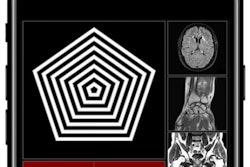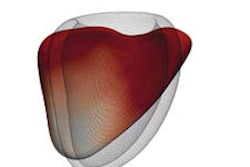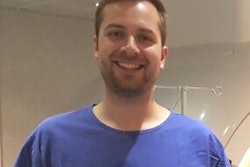
Cardiac MR (CMR) can be an intimidating modality to learn. Fortunately, resources such as the CMR Pocket Guide can make that task a whole lot easier, thanks to a broad range of CMR tools and reference information that can be useful both for education and in daily practice. CMR Pocket Guide is available as a native app for the iPhone and iPad, as well as a web app for other mobile platforms.
AuntMinnieEurope.com recently interviewed one of the app's co-developers, Dr. Bernhard Herzog, to learn more about CMR Pocket Guide, now on version 2.1. Herzog, of Heart Clinic Lucerne in Switzerland, co-developed the app with Dr. John Greenwood, PhD, and Dr. Sven Plein, PhD, of the University of Leeds in the U.K.
AuntMinnieEurope: What inspired you to create this app?
Herzog: CMR is rapidly gaining relevance in daily clinical practice and all cardiovascular imagers now need a good understanding of this modality. When I first started in CMR, I was a little overwhelmed by the technical jargon and the large amount of clinical data. I needed to learn to understand the basics of CMR, but there were no intuitive guides available that presented the essential knowledge in a compact form. This was the reason for developing three pocket guides that summarized the key technical and clinical information in small, but comprehensive booklets.
These pocket guides were very well received by the CMR community and endorsed by the European Society of Cardiology [ESC]. Our app is based on the first of these pocket guides. For logistical reasons, we had already decided to switch to a downloadable PDF format that was optimized for viewing on a smartphone. This worked quite well, but the static images in the PDF were not very attractive for a cardiology-oriented audience. The logical next step was the development of a native smartphone app, which was made possible after we received support from Philips Healthcare.
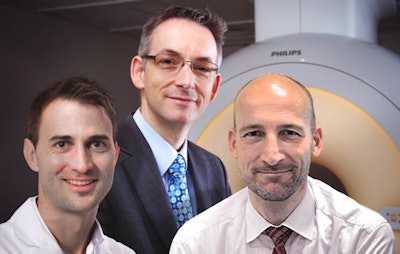 CMR Pocket Guide's developers (from left to right): Dr. Bernhard Herzog, Dr. John Greenwood, PhD, and Dr. Sven Plein, PhD.
CMR Pocket Guide's developers (from left to right): Dr. Bernhard Herzog, Dr. John Greenwood, PhD, and Dr. Sven Plein, PhD.What problem does the app help solve?
The app is designed to provide a day-to-day companion for those new to CMR and for those looking for a quick reference guide in routine practice. It provides an overview of clinical indications for CMR as well as common acquisition methods and established normal ranges for CMR measurements. For each indication we provide typical scan protocols, tips and tricks, a guide for reporting, as well as a large collection of clinical cases -- most of which are shown in movie format. We also added calculators for heart chamber volumes and extra cellular volume as assessed by myocardial T1 mapping methods.
How did you develop the app and how was the overall experience?
Most of the content of the app was already available from the printed version of the CMR Pocket Guide. We updated several chapters and added new content, but the main challenge was to transform a static electronic document into a dynamic, interactive, and attractive app. In retrospect, it all went very smoothly. You know, these days you hear a lot about "lean and agile" industrial processes in order to improve development efficiency, and I believe we have been doing exactly that. We had a small but versatile team with both shared and complementary knowledge and skills in cardiology, MR acquisition, image processing, and app development.
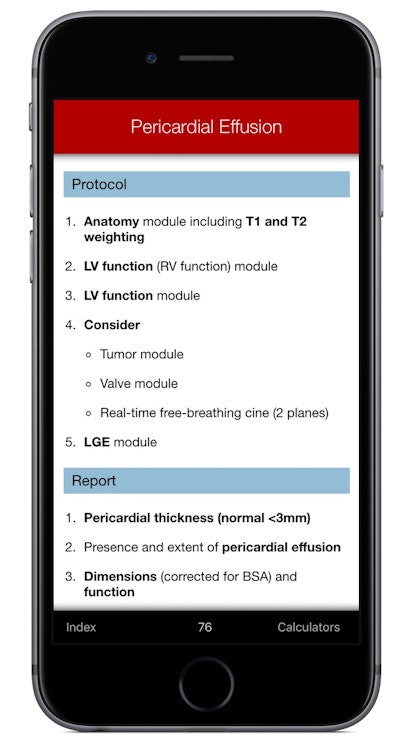 CMR Pocket Guide includes typical scan protocols and reporting tips. All images courtesy of Drs. Herzog, Greenwood, and Plein.
CMR Pocket Guide includes typical scan protocols and reporting tips. All images courtesy of Drs. Herzog, Greenwood, and Plein.Our software engineer created a rough prototype in just one day, which was immediately shared with the rest of the team using Apple's TestFlight program. From that moment onwards, content as well as all technical aspects and the UI of the app were added and evaluated on a weekly basis or so. We haven't had a single project meeting and we didn't use any functional requirement or tracking document. We communicated by email, decisions were made by text messages, and the functional requirement document was the app itself all the time. It was a great experience. Many late hours, but a lot of fun and actually not much "work" at all if you know what I mean.
Who is the target audience and how do you envision the app will be used?
This app is useful for anyone already practicing or starting up in CMR. For beginners, the app is a handy companion that lists the common CMR indications/scan protocols and gives many practical tips. For more experienced users, the reference values and the online calculators are the most useful features. The app can be used at the scanner to optimize acquisition protocols as well as during reporting, but is also a great tool for teaching.
What are the app's most important features? Could you describe what has been added with version 2.1 of the app?The most popular features of the app are the five built-in calculators to estimate heart chamber volumes from area and length measurements and [to estimate] extra cellular volume from T1 measurements. The calculators also provide gender and age-specific indexed normal values for the most common CMR measurements. In addition, the app does have a couple of interesting features that we believe are quite unique for mobile apps. Basically, it's a 116 page e-book. Therefore, we realized it was important that pages can be browsed smoothly and quickly, which can be done with a horizontal swipe. At the same time, each page can be scrolled vertically too, with vertical swipes. This was a fundamental technical challenge, which we solved successfully.
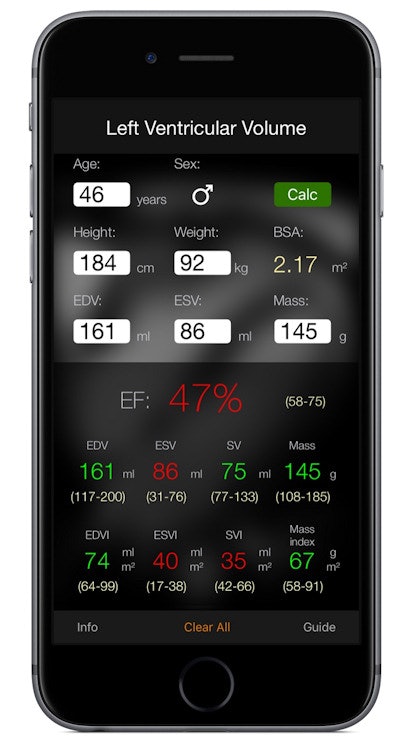 The app also features calculators for CMR tasks such as estimating heart chamber volumes.
The app also features calculators for CMR tasks such as estimating heart chamber volumes.The advantage is that we have no limit to the amount of text, images, and movies on each page, which helps to maintain a good structure even after adding new material. In addition, this is the only app we know that displays multiple movies -- sometimes even dozens of them -- on a single screen, all at the same time. Typically, apps can only run one movie at the time, which then has to be started manually. In CMR that is not the way it works. By using smart buffering techniques, the app combines the display of dozens of continuously running movies with fast page browsing. That creates a great user experience.
The latest version 2.1 is what we call a "point release." It has added content such as new clinical cases, a revised chapter on iron overload cardiomyopathy, and new chapters for common differential diagnoses. Version 2.0 was a more structural update that extended the app to iPads too, rather than only iPhones.
How many users do you have currently?The app has an international perspective and includes users from all around the globe. Since the launch at the annual meeting of the Society for Cardiovascular MR at the end of January 2016, we have more than 2,000 active users on iPhone and almost 1,700 unique users of the web app. Half of the users are from Europe, 26% are from the U.S. and Canada, and 14% from Asia Pacific.
What are your future plans for the app? Are there any new features or content in the works? Doyou plan to develop a version for Android?We have already developed a version for Android and other platforms. It is a web app that you can access by creating a desktop link to www.cmr-guide.com. The advantage of the web version is that you can access it from any platform, including your MR scanner if it has access to the internet. The contents are identical to the native iOS app, albeit sometimes with a small delay because the iOS version is our platform for development. And yes, we have many plans and ideas for the future.
We will definitely add more content, additional chapters, and more clinical cases. Maybe we will add some chapters about MR physics too. We are also considering allowing active involvement of the app's user community, perhaps so that users can upload their own cases. We plan to add more calculators and maybe an interactive tool to help understand cardiac anatomy and cardiac MR planning. This app is very inspiring and we have heaps of ideas!
Have you developed any other apps, or do you intend to?
This was our first app. We have learned the trade as the project moved on and yes, we do have ideas for other apps. These will need to be worked out, but we have shown we can do it, and we all enjoyed the experience -- even though it all happened in our spare time!
CMR Pocket Guide can be downloaded for free from the iTunes App Store and is also available as a web app for other platforms.





